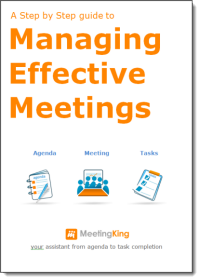Our goal is to help you improve your meetings. MeetingKing is a great tool to help you with the documentation and information distribution before, during and after your meetings and to make sure that things get done. However it is still up to the chair to manage the meeting and stay focused on the issue at hand.
Robert’s Rules of Order can help. We have some basic information on Robert’s Rules on our web site, but Susan Leahy of www.RobertsRulesMadeSimple.com is the expert in the area and offers in this article a few very practical tips on how you can start with Robert’s Rules of Order in your organization. Make sure you watch the video.
Robert’s Rules – just the Basics Please!
Do your meetings follow Robert’s Rules of Order? Or at least are they supposed to?
I’m going to go out on a limb here by saying that I am probably not the only person on the planet who thinks Robert’s Rules of Order is overly confusing and hard to understand.
But what makes this stuff seem so difficult?
The Problem
In my humble opinion:
- The book is too long for the average person. – It is over 700 pages after all! If you are like me, you can barely read all your emails let alone a book this thick!
- The book tends to be too detailed for the average board member’s needs. Not only are most board members busy people with competing priorities, by focusing too much on the details we can lose sight of the big picture of why we are in the organization in the first place.
- There is a barrier to entry for new users of Robert’s because at first it can feel like you are speaking a totally different language.
Yes of course, in EXTREME cases there is a need for all the detail that Robert’s Rules of Order provides. But those EXTREME cases do not apply to the majority of boards!
Most boards need to only get comfortable with the BASICS of Robert’s Rules of Order. Having a practical, working understanding of the BASICS will help any board get more work done.
Written right in the preface of Robert’s Rules of Order 10th Edition (I know the 11th edition came out in 2012 but I love this quote!!) it states:
“…but one of the greatest needs in parliamentary procedure today is for an increased yet relatively small, BASIC portion of it to become the common property of everyone, much as the rules of baseball.”
I firmly agree with this statement because when everyone on a board has an understanding of the basics of Robert’s then meetings can be more efficient (shorter), effective (productive) and engaging (fun!).
The Solution
At www.RobertsRulesMadeSimple.com we focus on teaching board members the BASICS because that is all most of them really need.
You might be thinking: THE BASICS? The book is 700 pages long, so where does someone start? Well, here are 3 tips to get you and your board started:
Tip #1. – Learn the 7 Fundamental Motions!
I have found that there are only 7 Motions that most board members need to learn about. Knowing how to make, and vote on each of these motions will exponentially improve your board’s effectiveness. The 7 Fundamental Motions are:
- The Main Motion
- Amendment
- Amend the Amendment
- Refer to a Committee
- Postpone to a Certain Time
- Lay on the Table
- Previous Question
Here is a video to get you started with learning these 7 Fundamental Motions: https://www.youtube.com/watch?v=eYwKX_P8YkU
Tip #2. – Start your meetings with a short training
This is a simple but powerful tip. Too many boards act like they know what they are doing, when they really don’t. Don’t assume everyone knows how to use Robert’s Rules of Order.
I suggest taking 10 minutes at the start of each meeting to make sure everyone really understands how to make and vote on each of the motions listed above! If you handled 1 motion per meeting, in just 7 meetings you would have done a complete training for your entire board.
#3. – Give your chair a little support
Whoever chairs your meetings has the single largest impact on the success of that meeting.
Make sure that your chair has had some training with Robert’s Rules of Order. It is unfair to everyone in the room (including the chair) to ask a person to run a meeting using Robert’s Rules of Order without providing them with a little support.
Make sure that the chair has one other person in the room that will play the role of “Parliamentarian”. Nothing throws a meeting off more than when a chair gets lost and everyone in the room starts to throw out their opinions about what the chair should be doing. To stop this from happening, the chair can look to the “Parliamentarian” to help them figure out an orderly way to get the meeting back on track. Remember if your chair is doing a great job then your meeting will be more productive and your members will feel more motivated!
I have been helping boards for over 15 years with Robert’s Rules of Order, so please just hear that you don’t need to be an expert in Robert’s. You just need to learn the basics!
Susan Leahy MA
Founder of www.RobertsRulesMadeSimple.com


